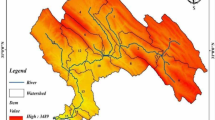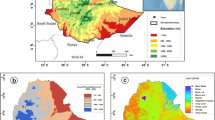Abstract
Soil freeze depth (SFD) is necessary to evaluate the variations in water resource balances, surface energy exchanges, and biogeochemical cycles in the frozen ground regions, while the variability of regional SFD under climate changes remains unknown, mainly due to the insufficiency of effective observations. Significant changes of frozen ground related to water resources and the eco-environment have occurred in the Upper Brahmaputra River Basin (UBRB) (also known as the Yarlung Zangbo River) on the southern Tibetan Plateau, which is a key area where SFD monitoring is scarce. In this study, we adopted the Stefan equation to simulate the regional maximum SFD over the UBRB from 1901 to 2016 with monthly near-surface air temperatures from the University of East Anglia Climatic Research Unit (UEA-CRU) and the University of Delaware (UDEL). Observations from 11 national meteorological stations over the UBRB and 6 nearby were used to calibrate relevant parameters and evaluate the simulations. Studies showed that maximum SFD is positively correlated with air freezing index (AFI), ground surface freezing index (GFI), and snow depth (SD) and is negatively correlated with air thawing index (ATI), ground surface thawing index (GTI), mean annual air temperature (MAAT), and mean annual ground surface temperature (MAGST). Approximately 97.94% and 96.21% of the UBRB were covered with the frozen ground as simulated with the UEA-CRU and the UDEL, respectively. The maximum SFD calculated with the UEA-CRU and the UDEL decreased respectively by about 0.31 m and 0.15 m over the past 116 years. Simulations with both datasets demonstrated that no significant changes of SFD occurred in the past four 30-year periods (i.e., 1901–1930, 1931–1960, 1961–1990, and 1991–2016), while the maximum SFD calculated with the UEA-CRU was smaller than that with the UDEL. All of these features demonstrated a warming trend of frozen ground from 1901 to 2016 in the UBRB.






Similar content being viewed by others
References
Ahmed A, Nawaz R, Woulds C, Drake F (2020) Influence of hydro-climatic factors on future coastal land susceptibility to erosion in Bangladesh: a geospatial modelling approach. Journal of Geovisualization and Spatial Analysis 4:6
Ferreira A, Vieira g, Ramos M, Nieuwendam A (2017) Ground temperature and permafrost distribution in Hurd Peninsula (Livingston Island, Maritime Antarctic): an assessment using freezing indexes and TTOP modelling. Catena 149:560–571
Frauenfeld OW, Zhang T, Barry RG and Gilichinsky D (2004) Interdecadal changes in seasonal freeze and thaw depths in Russia. J Geophys Res 109:D05101
Frauenfeld OW, Zhang T, McCreight JL (2007) Northern Hemisphere freezing/thawing index variations over the twentieth century. Int J Climatol 27:47–63
Guo D, Yang M, Wang H (2011) Characteristics of land surface heat and water exchange under different soil freeze/thaw conditions over the central Tibetan Plateau. Hydrol Process 25:2531–2541
Harris SA, Brouchkov A, Guodong C (2018) Geocryology: an introduction to frozen ground. CRC Press, pp 1–8
Henry K, Smith M (2001) A model-based map of ground temperatures for the permafrost regions of Canada. Permafr Periglac Process 12:389–398
Hu G, Zhao L, Li R, Wu X, Wu T, Xie C, Zhu X, Su Y (2019) Variations in soil temperature from 1980 to 2015 in permafrost regions on the Qinghai-Tibetan Plateau based on observed and reanalysis products. Geoderma 337:893–905
Jin H, Luo D, Wang S, Lü L, Wu J (2011) Spatiotemporal variability of permafrsot degradation on the Qinghai-Tibet Plateau. Sci Cold Arid Reg 3:0281–0305
Kurylyk BL, Hayashi M (2016) Improved Stefan equation correction factors to accommodate sensible heat storage during soil freezing or thawing. Permafr Periglac Process 27:189–203
Lu Q, Zhao D, Wu S (2017) Simulated responses of permafrost distribution to climate change on the Qinghai-Tibet Plateau. Sci Rep 7:3845
Luo D, Jin H, Jin X, He R, Li X, Muskett RR, Marchenko SS, Romanovsky VE (2018a) Elevation-dependent thermal regime and dynamics of frozen ground in the Bayan Har Mountains, northeastern Qinghai-Tibet Plateau, SW China. Permafr Periglac Process 29:257–270
Luo D, Jin H, Marchenko SS, Romanovsky VE (2018b) Difference between near-surface air, land surface and ground surface temperatures and their influences on the frozen ground on the Qinghai-Tibet Plateau. Geoderma 312:74–85
Luo D, Jin H, Wu Q, Bense VF, He R, Ma Q, Gao S, Jin X, Lu L (2018c) Thermal regime of warm-dry permafrost in relation to ground surface temperature in the source areas of the Yangtze and Yellow rivers on the Qinghai-Tibet Plateau, SW China. Sci Total Environ 618:1033–1045
Luo D, Liu L, Huijun J, Wang X, Chen F (2020) Characteristics of ground surface temperature at Chalaping in the source area of the Yellow River, northeastern Tibetan Plateau. Agric For Meteorol 281:107819
Ma L, Qin D (2012) Spatial-temporal characteristics of observed key parameters for snow cover in China during 1957–2009. J Glaciol Geocryol 34(01):1–11
Menne MJ, Durre I, Vose RS, Gleason BE, Houston TG (2012) An overview of the global historical climatology network-daily database. J Atmos Ocean Technol 29:897–910
Nelson FE, Outcalt SI (1987) A computational method for prediction and regionalization of permafrost. Arct Alp Res 19:279–288
Peng X, Zhang T, Frauenfeld OW, Wang K, Cao B, Zhong X, Su H, Mu C (2017) Response of seasonal soil freeze depth to climate change across China. Cryosphere 11:1059–1073
Peng X, Zhang T, Frauenfeld OW, Du R, Wei Q, Liang B (2020) Soil freeze depth variability across Eurasia during 1850–2100. Clim Chang 158:531–549
Peng X, Zhang T, Frauenfeld OW, Wang S, Qiao L, Du R, Mu C (2019) Northern Hemisphere greening in association with warming permafrost. J Geophys Res: Biogeosci 125:e2019JG005086
Peterson TC, Vose R (1998) Global Historical Climatology Network (GHCN) quality control of monthly temperature data. Int J Climatol 18:1169–1179
Qin Y, Wu T, Zhao L, Wu X, Li R, Xie C, Pang Q, Hu G, Qiao Y, Zhao G, Liu G, Zhu X, Hao J (2017) Numerical modeling of the active layer thickness and permafrost thermal state across Qinghai-Tibetan Plateau. J Geophys Res: Atmos 122:11,604–11,620
Qin Y, Liu W, Guo Z, Xue S (2020) Spatial and temporal variations in soil temperatures over the Qinghai–Tibet Plateau from 1980 to 2017 based on reanalysis products. Theor Appl Climatol 140:1055–1069
RAN Y, Li X, Cheng G, Zhang T, Wu Q, Jin H, Jin R (2012) Distribution of permafrost in China: an overview of existing permafrost maps. Permafr Periglac Process 23:322–333
Ran Y, Li X, Cheng G (2018) Climate warming over the past half century has led to thermal degradation of permafrost on the Qinghai–Tibet Plateau. Cryosphere 12:595–608
Shi Y, Niu F, Lin Z, Luo J (2019) Freezing/thawing index variations over the circum-Arctic from 1901 to 2015 and the permafrost extent. Sci Total Environ 660:1294–1305
Shiklomanov NI, Nelson FE (2002) Active-layer mapping at regional scales: a 13-year spatial time series for the Kuparuk region, north-central Alaska. Permafr Periglac Process 13:219–230
Smith MW, Riseborough DW (2002) Climate and the limits of permafrost: a zonal analysis. Permafr Periglac Process 13:1–15
Wang B, French HM (1994) Climate controls and high-altitude permafrost, Qinghai-Xizang (Tibet) Plateau, China. Permafr Periglac Process 5:87–100
Willmott CJ, Robeson SM (1995) Climatologically Aided Interpolaton (CAI) of terrestrial air temperature. Int J Climatol 15:221–229
Wu Q, Zhang T (2008) Recent permafrost warming on the Qinghai-Tibetan Plateau. J Geophys Res 113:D13108
Wu Q, Zhang T (2010) Changes in active layer thickness over the Qinghai-Tibetan Plateau from 1995 to 2007. J Geophys Res 115:D09107
Wu T, Wang Q, Zhao L, Batkhishig O, Watanabe M (2011) Observed trends in surface freezing/thawing index over the period 1987–2005 in Mongolia. Cold Reg Sci Technol 69:105–111
Wu Q, Zhao H, Zhang Z, Chen J, Liu Y (2019) Long-term role of cooling the underlying permafrost of the crushed rock structure embankment along the Qinghai–Xizang railway. Permafr Periglac Process 31:172–183
Zhang T, Frauenfeld OW, Serreze MC, Etringer A, Oelke C, McCreight J, Barry RG, Gilichinsky D, Yang D, Ye H, Ling F, Chudinova S (2005) Spatial and temporal variability in active layer thickness over the Russian Arctic drainage basin. J Geophys Res 110:D16101
Zhang YL, Li X, Cheng GD, Jin HJ, Yang DW, Flerchinger GN, Chang XL, Wang X, Liang J (2018) Influences of topographic shadows on the thermal and hydrological processes in a cold region mountainous watershed in Northwest China. J Adv Model Earth Sy 10:1439–1457
Zhao L, Ping C-L, Yang D, Cheng G, Ding Y, Liu S (2004) Changes of climate and seasonally frozen ground over the past 30 years in Qinghai–Xizang (Tibetan) Plateau, China. Glob Planet Chang 43:19–31
Zhou Y, Guo D, Qiu GQ, Cheng GD, Li S (2000) Frozen ground in China. Science Press, Beijing, pp 367–376
Zhou Z, Ma W, Zhang S, Du H, Mu Y, Li G (2016) Multiaxial creep of frozen loess. Mech Mater 95:172–191
Zhou Z, Ma W, Zhang S, Mu Y, Li G (2020) Experimental investigation of the path-dependent strength and deformation behaviours of frozen loess. Eng Geol 265:105449
Acknowledgments
We thank the editor and the anonymous reviewers for their helpful comments and constructive suggestions.
Funding
This research is supported by the National Natural Science Foundation (NSF) of China (Grant Nos. 91747201 and 41671060).
Author information
Authors and Affiliations
Corresponding author
Additional information
Publisher’s note
Springer Nature remains neutral with regard to jurisdictional claims in published maps and institutional affiliations.
Rights and permissions
About this article
Cite this article
Liu, L., Luo, D., Wang, L. et al. Variability of soil freeze depth in association with climate change from 1901 to 2016 in the upper Brahmaputra River Basin, Tibetan Plateau. Theor Appl Climatol 142, 19–28 (2020). https://doi.org/10.1007/s00704-020-03291-4
Received:
Accepted:
Published:
Issue Date:
DOI: https://doi.org/10.1007/s00704-020-03291-4




